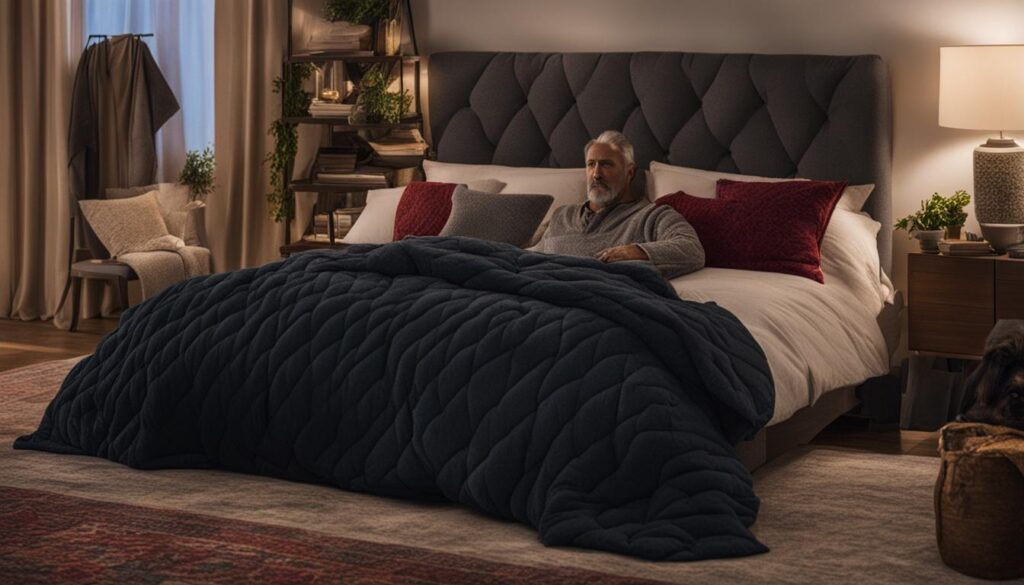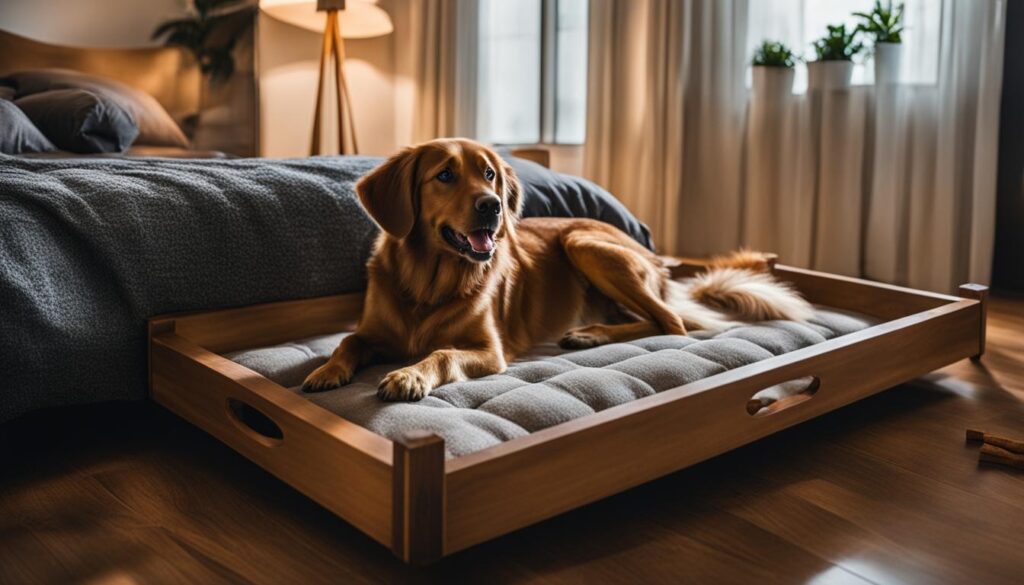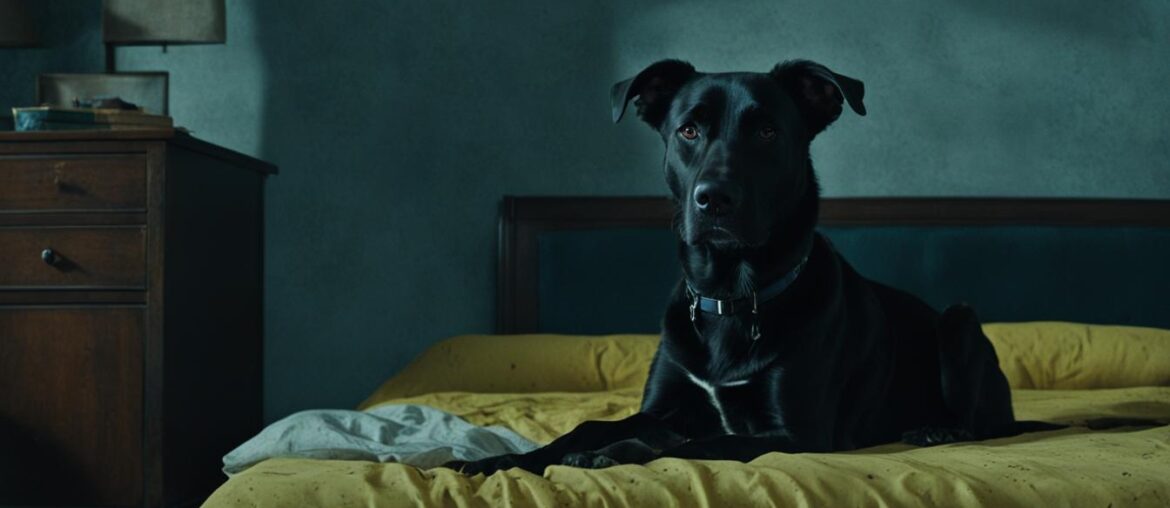If your dog is peeing on your bed, it can be frustrating and difficult to deal with. There are several possible reasons why dogs engage in this behavior, ranging from medical issues to behavioral problems. It’s important to identify the underlying cause before you can effectively address and stop your dog from peeing on your bed. Consulting with a veterinarian is recommended to rule out any medical conditions.
House training a dog is a crucial part of preventing accidents in the house and teaching them appropriate bathroom habits. In this article, I will provide you with practical solutions and effective strategies to stop your dog from peeing on your bed and maintain a clean living space.
Key Takeaways:
- Consult with a veterinarian to rule out any medical conditions causing your dog to pee on your bed.
- Identify behavioral causes such as marking territory or anxiety, and address them accordingly.
- Proper house training and reinforcement, including crate training, can help prevent accidents.
- Create a stress-free environment for your dog by reducing triggers and considering anxiety medications if necessary.
- Thoroughly clean your bed to remove any urine scent and discourage future accidents.
Medical Causes of Dogs Peeing on Beds
Dogs may urinate on beds due to underlying medical conditions. Urinary tract infections, bladder issues, and incontinence can cause dogs to have accidents, including peeing on beds. Other conditions like diabetes can also affect a dog’s urinary tract. It is essential to have your dog evaluated by a veterinarian to determine if any medical issues are contributing to the behavior.
Behavioral Causes of Dogs Peeing on Beds

Dogs may exhibit the behavior of peeing on beds for various behavioral reasons. Understanding these causes is key to addressing and resolving the issue. Let’s explore three common behavioral causes that can contribute to dogs urinating on beds: marking territory, submissive urination, and anxiety.
Marking Territory
One possible reason why dogs urinate on beds is to mark their territory. Dogs have a strong instinct to establish their scent in the household as a way of claiming ownership. By urinating on the bed, they leave their scent behind, indicating that the bed is part of their territory. This behavior is more common in unneutered male dogs, but females can also exhibit territorial marking.
Submissive Urination
Submissive urination is another behavioral cause that may lead to dogs peeing on beds, especially in younger dogs. It is a display of extreme submission and anxiety. When dogs feel threatened, intimidated, or overly excited, they may involuntarily release urine as a submissive gesture. This behavior is often seen in puppies or shy and anxious dogs.
Anxiety
Anxiety can play a significant role in dogs urinating on beds. Just like humans, dogs can experience stress, anxiousness, and fear, which can manifest in various ways, including inappropriate urination. Separation anxiety, changes in the household environment, or traumatic experiences can trigger anxiety in dogs and lead to accidents on the bed.
House Training and Reinforcement

Proper house training is essential to prevent dogs from peeing on beds. By using consistent and positive reinforcement-based training methods, you can teach your dog where they should eliminate. Crate training can also be an effective tool to prevent accidents when you’re not around to supervise.
Here are some key strategies for successful house training and reinforcement:
- Set a Schedule: Establish a regular routine for your dog’s bathroom breaks. Take them outside at consistent intervals throughout the day, especially after meals, naps, and playtime.
- Choose a Designated Bathroom Area: Select a specific spot in your yard where you want your dog to go potty. Take them to this area consistently, and encourage them to eliminate there.
- Use Positive Reinforcement: When your dog successfully goes potty outside, reward them with praise, treats, or a favorite toy. Positive reinforcement helps reinforce their understanding of appropriate elimination behavior.
- Be Patient and Consistent: House training takes time and patience. Stick to the established routine, and be consistent with your training methods. Avoid punishing or scolding your dog for accidents, as it can create fear and confusion.
- Monitor Supervision: Keep a close eye on your dog, especially during the initial stages of house training. Supervision allows you to redirect them to the appropriate bathroom area and prevent accidents on the bed.
Crate training can be an effective component of house training. When properly introduced, a crate provides a safe and secure space for your dog when you cannot supervise them. Dogs typically avoid eliminating in their designated sleeping area, which makes the crate a useful tool in preventing accidents.
Remember to gradually introduce the crate, make it comfortable with bedding and toys, and use positive reinforcement to associate it with positive experiences. Avoid using the crate as a form of punishment.
Sample Crate Training Schedule:
| Time | Activity |
|---|---|
| 7:00 AM | Take dog out of the crate for morning bathroom break and exercise. |
| 7:30 AM | Feed your dog breakfast and provide water. |
| 8:00 AM | Take your dog outside for a bathroom break. |
| 8:30 AM | Place your dog in the crate with a favorite toy or treat while you’re away. |
| 11:30 AM | Return home and take your dog outside for a bathroom break and exercise. |
| 12:00 PM | Feed your dog lunch and provide water. |
| 12:30 PM | Take your dog outside for a bathroom break. |
| 1:00 PM | Place your dog in the crate with a favorite toy or treat while you’re away. |
| 4:30 PM | Return home and take your dog outside for a bathroom break and exercise. |
| 5:00 PM | Feed your dog dinner and provide water. |
| 5:30 PM | Take your dog outside for a bathroom break. |
| 6:00 PM | Place your dog in the crate with a favorite toy or treat while you’re away. |
| 9:30 PM | Return home and take your dog outside for a final bathroom break before bedtime. |
This crate training schedule provides structure and consistency, ensuring that your dog has regular bathroom breaks and avoids accidents on the bed. Remember, the duration of crate confinement should be appropriate for your dog’s age and bladder capacity.
Environmental Modifications

Creating a stress-free environment for your dog is essential in reducing their anxiety-related urination issues. Dogs are sensitive to changes in their surroundings, so it’s important to consider and address any factors that may cause stress or trigger their anxiety.
One effective way to reduce stress in dogs is to maintain a consistent routine. Dogs thrive on predictability, so sticking to a regular schedule for feeding, exercise, and bathroom breaks can help create a sense of stability for them.
Another helpful modification is to provide a designated space where your dog feels safe and secure. This can be a cozy corner with a comfortable bed, blankets, and toys. Having a dedicated area helps them feel more at ease and provides a retreat when they need it.
Additionally, consider using calming aids such as pheromone diffusers or calming music to create a soothing atmosphere. These aids can help reduce anxiety and promote relaxation in your dog.
If environmental modifications alone are not sufficient, consulting with a veterinarian about anxiety medications or supplements may be beneficial. They can provide guidance on suitable options and help determine the correct dosage for your dog’s specific needs.
Remember, creating a stress-free environment is a gradual process. Patience and consistency are key in helping your dog feel more secure and reducing their anxiety-related urination issues.
Creating a stress-free environment for your dog can help alleviate anxiety-related urination issues.
| Environmental Modifications | Description |
|---|---|
| Stick to a consistent routine | Maintain regular schedules for feeding, exercise, and bathroom breaks to create stability and predictability for your dog. |
| Provide a designated safe space | Create a comfortable corner or area where your dog can retreat to when they feel stressed or anxious. |
| Use calming aids | Consider using pheromone diffusers or calming music to create a soothing atmosphere for your dog. |
| Consult with a veterinarian | If environmental modifications alone are not sufficient, seek professional advice regarding anxiety medications or supplements. |
Cleaning and Odor Removal
Thoroughly cleaning and removing urine odor from the bed is essential in preventing dogs from repeatedly urinating on it. Using an enzymatic urine cleaner can effectively eliminate the scent and discourage the dog from considering the bed as a toilet spot. Regularly washing and changing bedding can also help maintain a clean and odor-free environment.
When it comes to removing dog urine smell, enzymatic urine cleaner is highly recommended. Unlike conventional cleaners, enzymatic urine cleaners break down the urine molecules and eliminate the odor at the source. This powerful cleaning solution not only removes the smell but also discourages dogs from returning to the same spot.
“Enzymatic urine cleaners are specifically formulated to eliminate odor-causing molecules. They contain enzymes that break down the proteins in urine, eliminating the odor and discouraging pets from re-soiling.”
In addition to using an enzymatic urine cleaner, it’s crucial to clean bedding regularly. Dogs have a heightened sense of smell, and even a faint trace of urine odor can signal that the bed is an acceptable place to eliminate. To maintain a clean and odor-free environment, wash bedding with pet-friendly detergent and hot water. Consider using a mild disinfectant to further ensure cleanliness.
Remember, consistency is key. Follow a regular cleaning routine to prevent the buildup of urine smell and maintain a fresh and hygienic sleeping area for both you and your pet.
| Cleaning Tips | Benefits |
|---|---|
| Use enzymatic urine cleaner | – Eliminates urine odor – Discourages dogs from re-soiling |
| Wash bedding regularly | – Removes any residual urine scent – Maintains cleanliness and hygiene |
| Consider using a mild disinfectant | – Provides extra assurance of cleanliness – Eliminates bacteria and odors |
Supervision and Management Techniques

When it comes to preventing accidents and curbing the behavior of your dog peeing on the bed, effective supervision and management techniques play a crucial role. By implementing the following strategies, you can create an environment that encourages appropriate bathroom habits and restricts access to the bed:
Restrict Access to Bed
To prevent your dog from peeing on the bed when you’re not around, it’s essential to limit their access to the bedroom. Keeping the bedroom doors closed can serve as a physical barrier, ensuring that your furry friend can’t enter the area with the bed. This simple step can significantly reduce the likelihood of accidents occurring.
Frequent Bathroom Breaks
A key element of successful house training is providing your dog with frequent bathroom breaks. Taking your dog outside at regular intervals throughout the day gives them the opportunity to eliminate outside of the house. This consistent routine reinforces appropriate bathroom habits and reduces the likelihood of accidents, including peeing on the bed.
Crate Training
Crate training can be an effective tool in preventing your dog from peeing on the bed. A crate provides a safe space for your dog when you’re unable to supervise them closely. By introducing them to the crate gradually and using positive reinforcement, such as treats and praise, you can teach your dog to view the crate as their den. Crating your dog when you’re away or unable to monitor their behavior can prevent accidents and promote proper house training.
By incorporating these supervision and management techniques into your dog care routine, you can create a structured and supportive environment that encourages appropriate bathroom habits and prevents your dog from peeing on the bed.
| Supervision and Management Techniques | Benefits |
|---|---|
| Restrict access to the bed | Prevents accidents and promotes proper bathroom habits |
| Frequent bathroom breaks | Reinforces appropriate elimination outside the house |
| Crate training | Provides a safe space and prevents accidents when unsupervised |
Seek Professional Help

If you’ve tried various methods to stop your dog from peeing on the bed without success, it may be time to seek professional guidance. A dog trainer or animal behaviorist can provide expert assistance in addressing this issue. They have the knowledge, skills, and experience to help you understand the underlying causes and implement effective training techniques to modify your dog’s behavior.
A dog trainer specializes in teaching dogs obedience and proper behavior through training sessions. They can assess your dog’s specific situation, identify triggers, and develop a tailored training plan to address the bed peeing behavior. With their professional guidance, you can learn the right techniques to communicate with your dog effectively and redirect their behavior to more appropriate elimination spots.
On the other hand, an animal behaviorist is an expert in understanding the psychological and emotional aspects of animal behavior. They can analyze your dog’s behavior holistically, taking into account any underlying medical conditions, anxiety, stress, or trauma that may be contributing to the bed peeing problem. With their knowledge in behavior modification, they can develop a comprehensive plan to help your dog overcome their urine marking behavior and establish healthier habits.
Both a dog trainer and an animal behaviorist will work closely with you and your dog to provide professional guidance and support throughout the training process. They can answer any questions you may have, make adjustments to the training plan as needed, and ensure you’re equipped with the necessary tools to address the bed peeing issue effectively.
Seeking professional help is an investment in your dog’s well-being and your peace of mind. With their expertise, you can gain valuable insights into your dog’s behavior and implement proven strategies to resolve the bed peeing problem. Don’t hesitate to reach out to a dog trainer or animal behaviorist for the professional assistance your dog needs.
Prevention Tips

Taking proactive measures and consistent training can help prevent dogs from urinating on beds. By addressing potential medical issues, implementing effective house training techniques, and creating a suitable environment, you can significantly reduce the likelihood of accidents. Continuous reinforcement and supervision are essential to maintaining proper bathroom habits.
Medical Considerations
Before addressing behavioral aspects, it is crucial to rule out any underlying medical conditions that may contribute to your dog’s urination on the bed. Consult with your veterinarian to ensure your dog’s health is in check. Medical issues such as urinary tract infections, bladder problems, incontinence, or diabetes can cause them to have accidents, including urinating on beds. Proper diagnosis and treatment will help resolve any medical causes.
House Training Techniques
Consistent house training is key to preventing dogs from urinating on beds. Start by establishing a designated bathroom area for your dog in your yard and consistently taking them there. Use positive reinforcement techniques, such as praise and treats, to reward them for eliminating in the appropriate area. Establish a regular potty schedule that aligns with your dog’s needs to avoid accidents indoors. Crate training can also be an effective tool to prevent accidents when you are not able to supervise your dog closely.
Creating a Suitable Environment
Modifying the environment can also contribute to preventing dogs from urinating on beds. Minimize stress and anxiety by ensuring your dog has a quiet and comfortable space to rest. Reduce triggers that may cause your dog to feel anxious, such as loud noises or unfamiliar visitors. Additionally, consider using pheromone sprays or diffusers designed to calm dogs and alleviate anxiety. These remedies can help create a more relaxed atmosphere and discourage urination on beds.
Continuous Reinforcement and Supervision
Consistency and reinforcement play a crucial role in preventing dogs from urinating on beds. Continue to reinforce positive behavior by rewarding your dog when they eliminate in the designated bathroom area. Provide frequent opportunities for your dog to relieve themselves outside, especially after meals or naps. Supervise your dog’s activities and limit access to the bed or bedroom when you are not able to closely monitor them. With consistent training and supervision, your dog will learn appropriate bathroom habits and avoid urinating on beds.
| Prevention Tip | Key Points |
|---|---|
| Address Medical Issues | Consult a veterinarian to rule out any medical conditions contributing to bed urination. Treat any underlying issues. |
| Implement House Training Techniques | Establish a consistent potty schedule, use positive reinforcement, and consider crate training. |
| Create a Suitable Environment | Reduce stress and anxiety, provide a comfortable space, and use calming remedies if needed. |
| Continuous Reinforcement and Supervision | Reinforce positive behavior, reward appropriate elimination, and closely supervise your dog’s activities. |
Wrapping Up
Dealing with a dog that pees on the bed can be challenging, but rest assured, there are practical solutions and effective strategies to resolve this issue. The key lies in identifying the underlying cause, whether it’s medical or behavioral. Understanding the root of the problem will enable you to implement the right approach.
Proper house training is crucial in preventing your dog from peeing on your bed. Consistency and positive reinforcement play a significant role in teaching your furry friend where they should eliminate. Additionally, making environmental modifications to minimize stress and anxiety can help address behavioral causes.
In some cases, seeking professional guidance from a dog trainer or animal behaviorist may be necessary. They can provide personalized advice, specialized training techniques, and behavior modification strategies tailored to your dog’s specific needs. Remember, prevention is key, so continuous reinforcement and supervision are essential to maintaining proper bathroom habits.
FAQ
What are some medical causes of dogs peeing on beds?
Dogs may urinate on beds due to urinary tract infections, bladder issues, incontinence, or diabetes. It’s important to have your dog evaluated by a veterinarian to rule out any medical issues.
What are some behavioral causes of dogs peeing on beds?
Dogs may pee on beds to mark territory, due to submissive urination, or as a result of anxiety and stress. Identifying triggers and minimizing stressors can help address these behavioral causes.
How can I house train my dog to prevent them from peeing on my bed?
Consistent and positive reinforcement-based training methods, such as crate training and providing frequent opportunities for your dog to relieve themselves outside, can help teach them proper elimination habits.
How can I modify the environment to prevent my dog from peeing on the bed?
Creating a stress-free environment for your dog, addressing any changes or stressors, and considering anxiety medications or supplements can help alleviate anxiety-related urination issues.
How do I clean and remove the urine odor from my bed?
Thoroughly cleaning the bed with enzymatic urine cleaner can effectively eliminate the scent and discourage the dog from urinating on it. Regularly washing and changing bedding can also help maintain a clean and odor-free environment.
What techniques can I use to manage and supervise my dog to prevent accidents on the bed?
Limiting your dog’s access to the bed when you’re not around by keeping bedroom doors closed or using crates or gates can help prevent accidents. Taking your dog out for frequent bathroom breaks and rewarding them for proper elimination can reinforce appropriate bathroom habits.
Should I seek professional help if my dog continues to pee on the bed?
If you’re not seeing progress with your efforts to stop your dog from peeing on the bed, it’s recommended to seek help from a professional dog trainer or animal behaviorist. They can provide personalized guidance, training techniques, and behavior modification strategies.
What are some prevention tips to avoid dogs peeing on beds?
Taking proactive measures such as thorough house training, managing the environment, and consistent reinforcement can significantly reduce the likelihood of accidents. Continuous supervision and reinforcement are key to maintaining proper bathroom habits.
How can I effectively stop my dog from peeing on my bed?
By identifying the underlying cause, implementing proper training techniques, and seeking professional help if needed, you can successfully stop your dog from peeing on your bed and maintain a clean living space.






